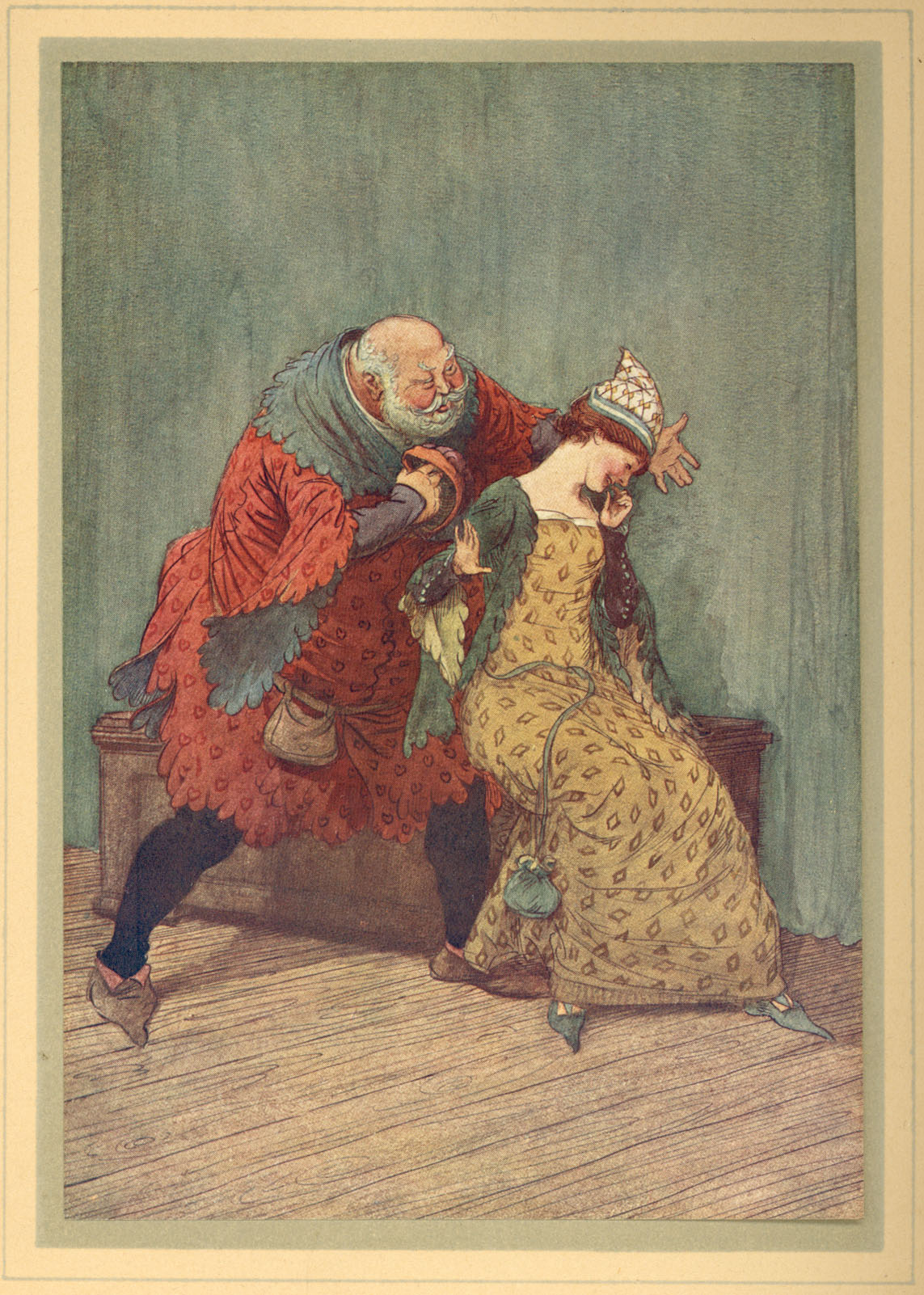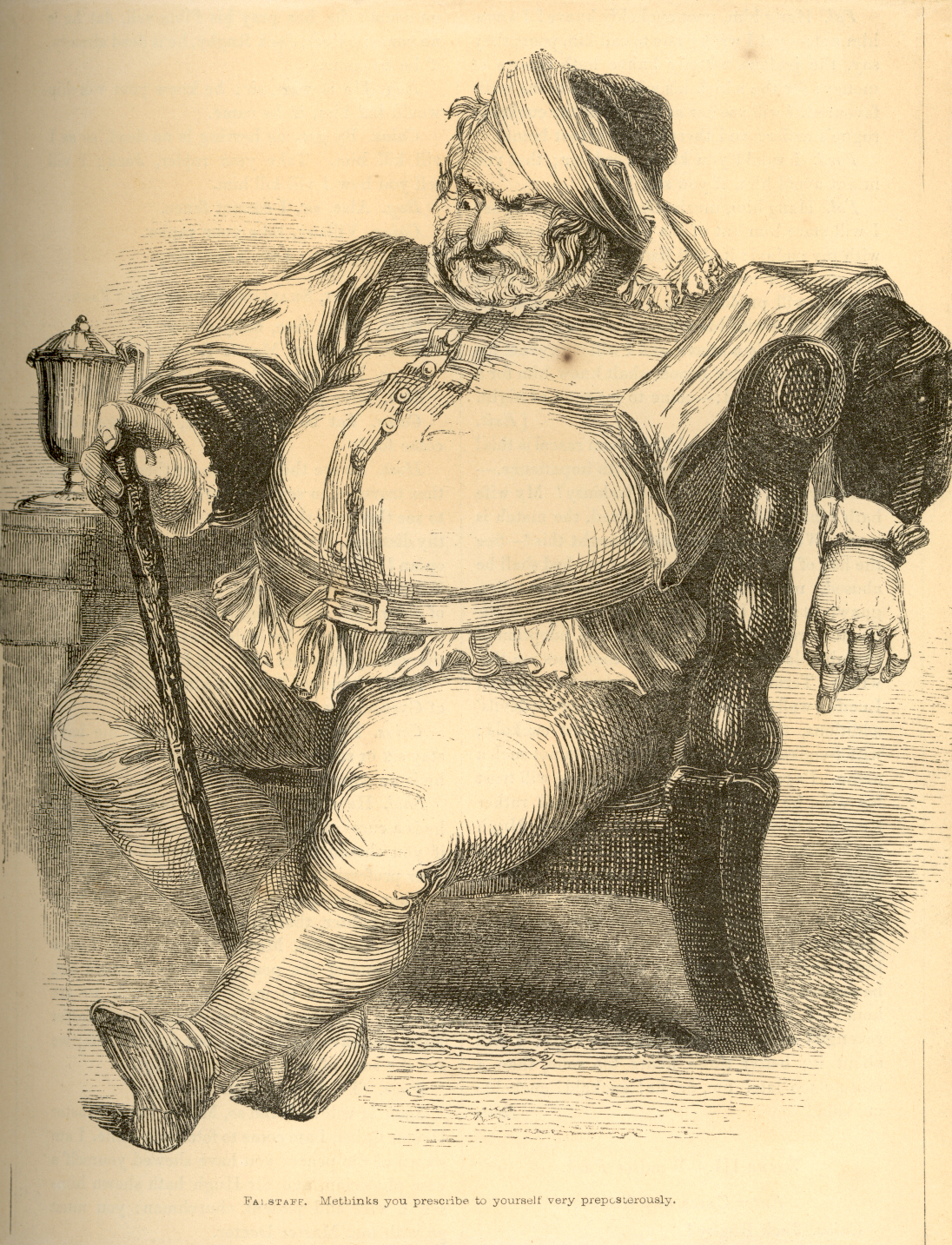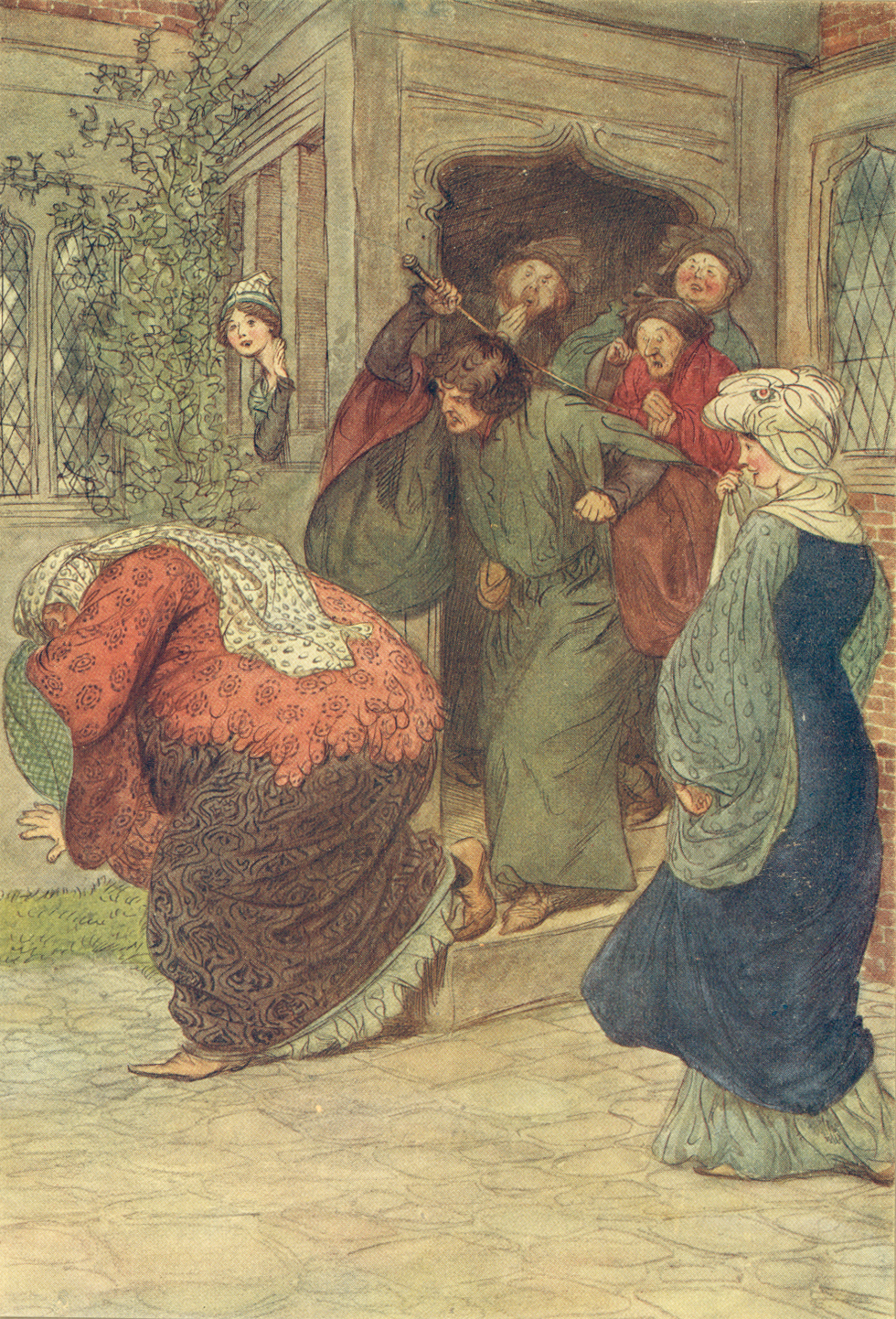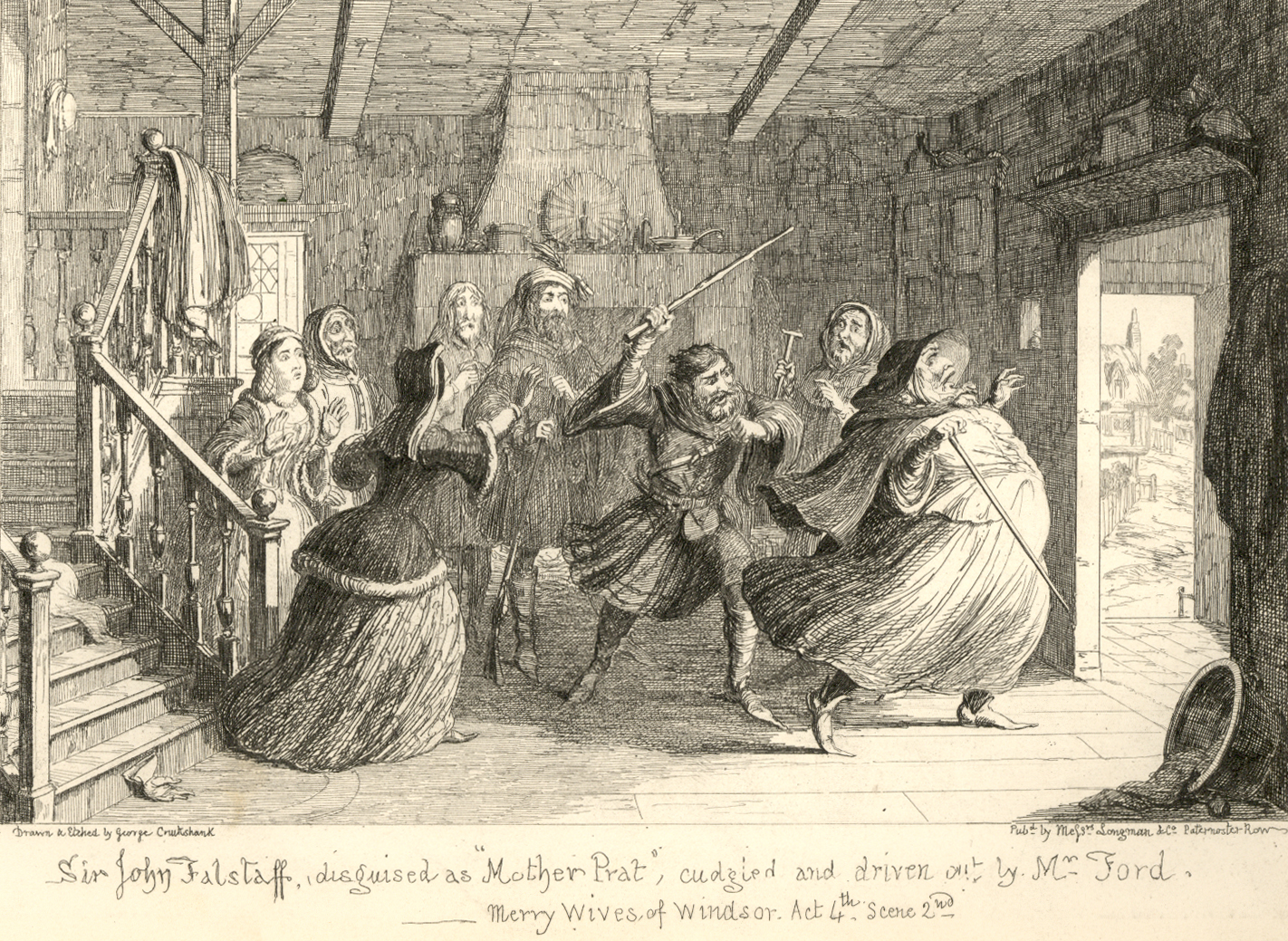By: Sydney Vollmer, ARB Intern
 In my previous blog I mentioned that the Cincinnati Shakespeare Company would be putting on free productions of Merry Wives of Windsor this summer as part of its Shakespeare in the Park series. If you’ve read the play or seen the show, you know a main plot point is about Sir John Falstaff and how he tries to seduce Mistress Page and her best friend, Mistress Ford—at the same time. Both women, faithful to their husbands, decide to create quite the fool out of Falstaff by feigning interest and arranging secret meetings between Falstaff and Mistress Ford. Those meetings are always interrupted by Master Ford coming home, thus putting Falstaff in precarious positions. One of the most notable scenes involves Falstaff donning a dress, pretending to be the fat aunt of the Fords’ servant so he can leave the house without being recognized. It’s been long thought of as one of the funniest scenes in the play…why? What is it about a man in a dress that gives us a big chuckle?
In my previous blog I mentioned that the Cincinnati Shakespeare Company would be putting on free productions of Merry Wives of Windsor this summer as part of its Shakespeare in the Park series. If you’ve read the play or seen the show, you know a main plot point is about Sir John Falstaff and how he tries to seduce Mistress Page and her best friend, Mistress Ford—at the same time. Both women, faithful to their husbands, decide to create quite the fool out of Falstaff by feigning interest and arranging secret meetings between Falstaff and Mistress Ford. Those meetings are always interrupted by Master Ford coming home, thus putting Falstaff in precarious positions. One of the most notable scenes involves Falstaff donning a dress, pretending to be the fat aunt of the Fords’ servant so he can leave the house without being recognized. It’s been long thought of as one of the funniest scenes in the play…why? What is it about a man in a dress that gives us a big chuckle?
There isn’t a short answer to this question, and people are rather divided in their opinions. Some think the humor is obvious because of the way it looks. The clothes don’t fit, so it just looks wrong. Some think it’s an offensive form of comedy because it doesn’t take into consideration the men and boys who may identify as female and therefore be more comfortable in women’s clothes. And some say the humor is derived from the age-old notion that men are inherently the superior sex, so when men dress as women, they are effectively downgrading their own status.
 Personally, I believe there is some truth in all of these, and that the humor is dependent on the character’s circumstances. A man who identifies as a woman and dresses as such is not funny because that is a lifestyle. He sees himself as a woman, so the rest of the world should respect that. However, a man who sees himself as a “man’s man” all dolled up in a mini skirt and pumps is hilarious, because the audience knows that if he saw himself he would be poking fun too.
Personally, I believe there is some truth in all of these, and that the humor is dependent on the character’s circumstances. A man who identifies as a woman and dresses as such is not funny because that is a lifestyle. He sees himself as a woman, so the rest of the world should respect that. However, a man who sees himself as a “man’s man” all dolled up in a mini skirt and pumps is hilarious, because the audience knows that if he saw himself he would be poking fun too.
How desperate is the person putting on the gown? Is it a personal choice or is it the only way for the man to escape an undesirable situation? If the donning of a dress doesn’t add anything to the storyline, it’s not going to be very funny.
So why is Merry Wives of Windsor’s use of cross-dressing funny?
In Shakespeare’s time, all characters in his plays were portrayed by men—even the women. So why is it funnier when Falstaff is forced to be a woman for a scene than the male actor portraying Mistress Ford, Mistress Page, or another female character in the play?
 In Elizabethan plays, this ploy would have been funny because audiences knew that there would be men portraying women. That wasn’t anything new. From the start of the play, they accepted the women characters as women, rather than men playing women. However, in the case of Falstaff, he starts the play as a man. Not only is he a man, but a very proud man. He is a knight who prides himself on his masculinity. When he is forced to become an old, fat woman, it’s nearly the last thing he would ever want for himself. His character has already proven himself to be boastful and stupid, so the audience isn’t exactly rooting for him. It’s always funny to see a villain getting what they deserve, especially if it comes from two strong, virtuous characters. Not to mention that Falstaff is a large man. The clothes he is wearing have to be big enough to accommodate his stature, and that is sure to be a sight. Pair that with the fact that if he is caught, he will be subjected to physical pain, humiliation, and have no hope of attaining his goal of wooing the women, it makes for a funny scene. Even today, when female actresses are involved in productions, this scene is funny because of the juxtaposition between the character’s bravado and his sticky situation.
In Elizabethan plays, this ploy would have been funny because audiences knew that there would be men portraying women. That wasn’t anything new. From the start of the play, they accepted the women characters as women, rather than men playing women. However, in the case of Falstaff, he starts the play as a man. Not only is he a man, but a very proud man. He is a knight who prides himself on his masculinity. When he is forced to become an old, fat woman, it’s nearly the last thing he would ever want for himself. His character has already proven himself to be boastful and stupid, so the audience isn’t exactly rooting for him. It’s always funny to see a villain getting what they deserve, especially if it comes from two strong, virtuous characters. Not to mention that Falstaff is a large man. The clothes he is wearing have to be big enough to accommodate his stature, and that is sure to be a sight. Pair that with the fact that if he is caught, he will be subjected to physical pain, humiliation, and have no hope of attaining his goal of wooing the women, it makes for a funny scene. Even today, when female actresses are involved in productions, this scene is funny because of the juxtaposition between the character’s bravado and his sticky situation.

To see this play and make your own decisions on the humor of this scene, check out the Cincinnati Shakespeare Company’s website, https://cincyshakes.com/shakespeare-in-the-park/. To view more images of Falstaff or any other Shakespearean characters, call the Archives & Rare Books Library at 513.556.1959 or emailing archives@ucmail.uc.edu. Our hours of operation are Monday through Friday, 8a-5p. We are located on the 8th floor of Blegen Library. Please give us a “like” on Facebook, check out our Shakespeare web page at http://libapps.libraries.uc.edu/exhibits/shakespeare400/ and don’t forget about our upcoming collaboration with the Cincinnati Museum Center on their Shakespeare exhibit – http://www.cincymuseum.org/shakespeare!
